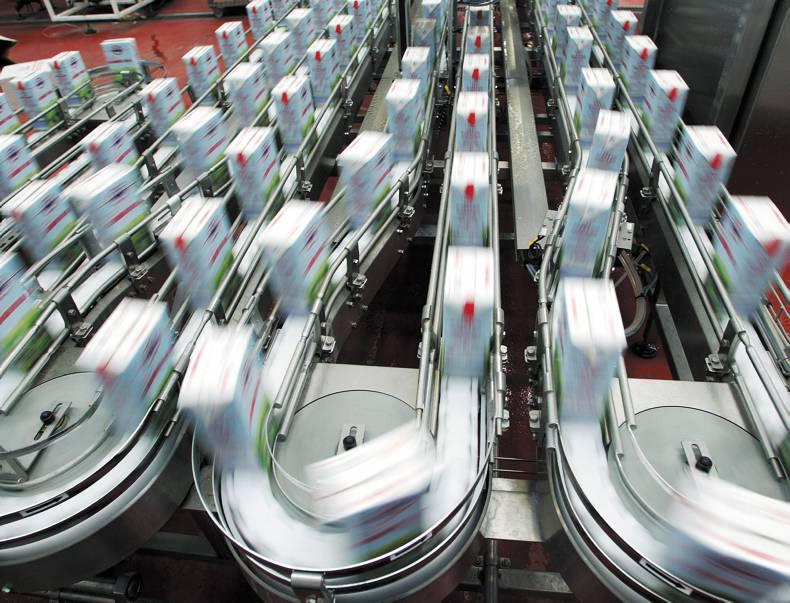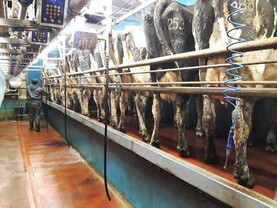As farmers around the world continue to pump out milk, global dairy demand beyond the parlour has changed dramatically in the past year.
In the first year since the lifting of milk quotas, global dairy prices have collapsed almost 50% despite many economists proclaiming that there would be a soft landing for dairy farmers on any removal.
So why are milk prices close to six-year lows in Ireland after just 12 months in a quota-free environment and near 10-year lows in New Zealand? How did everyone get it so wrong? There are three key reasons for the collapse in dairy prices:
Increased milk supply, caused by four main factors – removal of EU quotas, a weaker euro, relatively cheap grain and favourable weather.Reduced demand in key importing regions such as China and Africa caused by poorer economic conditions driven by falling commodity prices.Trade restrictions, especially Russia, have caused significant changes in traditional dairy trade flows.Supply side
Last year, total milk production around the world increased by 1.8% to almost 850bn litres. While 1.8% does not seem like much, it equates to an extra 15bn litres of milk.
Unsurprisingly, with the lifting of milk quotas, the EU as one of the world’s largest producers of milk (155bn litres) was responsible for just over one-quarter (26%) of this growth and supplied an extra 3.5bn litres of milk last year.
The US, with 95bn litres of milk, produced an extra 1.2bn litres, despite a 1.3% increase in supply. New Zealand, with its milk pool of 21bn litres, increased supply by 2.8%, adding 0.6bn litres extra. Ireland grew its milk pool by 13% to 6.4bn litres, which meant it added 0.8bn litres to global supply.
So, while the EU accounted for 25% of the global growth, the US accounted for only 8%. Ireland accounted for 6%, marginally below the US, and New Zealand accounted for 4%.
Within the EU, a total of five countries (the Netherlands, Ireland, Germany, UK, Poland) accounted for 85% of EU growth. The Netherlands and Ireland accounted for 50% of EU growth.
The Netherlands supply grew 6.8%, and supplied 0.9bn litres more milk. Ireland, despite being the eighth-largest producer in the EU, followed closely behind and supplied 0.8bn litres more. Germany, as the largest EU producer, grew a modest 1.6% and supplied 0.5bn litres extra. The UK supplied 0.4bn litres more on 2.5% growth.
Even though the EU accounted for the largest share of the supply growth, it has been unable to expand production for almost 30 years. During that time the rest of the world moved on. In 1985, there were a third fewer people in the world and dairy farmers globally produced just shy of 400bn litres.
Since that time, the US increased its production by almost 50%, while New Zealand quadrupled its milk pool from roughly the size of Ireland’s in 1985 to 21bn litres today.
Demand side
As most milk that is produced gets consumed in local markets, only 8% or 66bn litres of the world’s milk supply is traded between regions. Because of static demand in the EU, every litre of additional output must find a home on international markets.
Of the key exporting regions, New Zealand accounts for 45% of global dairy trade. Australia accounts for a further 7%. The EU accounts for a third, while the US accounts for 10%.
So even a tiny change in New Zealand’s or the EU’s supply or export destinations can have a dramatic effect on global markets, and this tiny change happened.
The Chinese effect
China is the single largest importer of dairy products in the world. China has been the greatest driver of dairy demand, with the country’s rapid economic expansion seeing its middle-class population swell.
Between 2010 and 2014, Chinese milk powder imports more than doubled to just under 760,000t per annum. In 2013 alone, China’s year-on-year milk powder imports rocketed by over 40% as the country’s buyers began to hoover up global stocks of milk powder.
However, after years of strong demand growth, 2015 saw a major drop-off in Chinese activity, with milk powder imports plunging by 40% to lower than 2012 levels. The fall-off has been attributed to the slowing Chinese economy.
Whether the dramatic surge in China’s powder imports in 2012 and 2013 was due to actual demand or more to do with supply chain mismanagement by Chinese buyers is difficult to see. We may be returning to more “normal” levels as seen in 2015.
That said, in the first two months of 2016, total dairy imports by China were more than 35% ahead of the same period last year in volume terms. If this can be sustained, it is a positive
signal.
How has this affected Ireland? Even though Irish dairy exports to China were €500m in 2015, Ireland has been hit more by the indirect effect. For example, Fonterra exported 28% (316,000t) less to China in the past 18 months.
As output didn’t change, it had to find new homes for this product in other markets. To offset the 316,000t drop, it moved 106,000t of this to Europe, the Middle East and Africa, 86,000t to southeast Asia markets and 85,000t to (mainly South) American markets.
This in effect flooded these markets, and caused countries that traditionally bought from the EU to buy from New Zealand, displacing EU product. A slight ripple becomes a wave.
The Russian effect
The Russian embargo since 2014 has meant EU dairy products that traditionally went to this market ended up homeless overnight. This had the effect of increasing the volume of EU exports to Asia.
However, because of poorer demand growth, those that traditionally supplied Asia ended up needing to find a new home for their product. The small wave starts to become a tsunami pretty quickly.
The oil effect
The collapsed oil market has certainly affected the buying power of oil-dependent economies, which are large dairy importers.
North African countries such as Nigeria and Algeria or the Middle East countries are important destinations for Irish dairy.
For example, Algeria is traditionally the EU’s largest export market for powders. However, import volumes of SMP, of which 92% comes from the EU, fell 16% in 2015 as a result of the fall in oil prices.
Algeria is also the second largest importer of WMP after China, and last year it bought 9% more, thanks to cheaper product flowing in from New Zealand.
This displaced EU product which had a 35% share in 2014 and a 16% share in
2015.
Comment
In theory, low milk prices should restrain growth in milk output globally. The surge in EU milk production last year was exceptional, given it was the first opportunity to grow in 30 years. EU production is expected to return to more normal growth levels of around 1% in the future.
In the US, low grain prices fuelled output growth over the last five years, where supply grew by an extra 1bn litres each year, making it a major player in the global dairy market.
The milk tap is projected to continue in the short term, with an additional 2.2bn litres in the EU and 1.3bn litres in the US expected in 2016. This will only be partially offset by the 4% falloff in supply from New Zealand.
Long-term global demand remains positive and is projected to be close to 2% per annum. However, currently this is not the case and demand needs to catch up with supply growth.
While import demand from China does appear to be recovering, the Russian ban remains a strong headwind coupled with weaker demand from oil-producing countries, which overall is affecting the trade flows and unable to soak up the additional supply.
As farmers around the world continue to pump out milk, global dairy demand beyond the parlour has changed dramatically in the past year.
In the first year since the lifting of milk quotas, global dairy prices have collapsed almost 50% despite many economists proclaiming that there would be a soft landing for dairy farmers on any removal.
So why are milk prices close to six-year lows in Ireland after just 12 months in a quota-free environment and near 10-year lows in New Zealand? How did everyone get it so wrong? There are three key reasons for the collapse in dairy prices:
Increased milk supply, caused by four main factors – removal of EU quotas, a weaker euro, relatively cheap grain and favourable weather.Reduced demand in key importing regions such as China and Africa caused by poorer economic conditions driven by falling commodity prices.Trade restrictions, especially Russia, have caused significant changes in traditional dairy trade flows.Supply side
Last year, total milk production around the world increased by 1.8% to almost 850bn litres. While 1.8% does not seem like much, it equates to an extra 15bn litres of milk.
Unsurprisingly, with the lifting of milk quotas, the EU as one of the world’s largest producers of milk (155bn litres) was responsible for just over one-quarter (26%) of this growth and supplied an extra 3.5bn litres of milk last year.
The US, with 95bn litres of milk, produced an extra 1.2bn litres, despite a 1.3% increase in supply. New Zealand, with its milk pool of 21bn litres, increased supply by 2.8%, adding 0.6bn litres extra. Ireland grew its milk pool by 13% to 6.4bn litres, which meant it added 0.8bn litres to global supply.
So, while the EU accounted for 25% of the global growth, the US accounted for only 8%. Ireland accounted for 6%, marginally below the US, and New Zealand accounted for 4%.
Within the EU, a total of five countries (the Netherlands, Ireland, Germany, UK, Poland) accounted for 85% of EU growth. The Netherlands and Ireland accounted for 50% of EU growth.
The Netherlands supply grew 6.8%, and supplied 0.9bn litres more milk. Ireland, despite being the eighth-largest producer in the EU, followed closely behind and supplied 0.8bn litres more. Germany, as the largest EU producer, grew a modest 1.6% and supplied 0.5bn litres extra. The UK supplied 0.4bn litres more on 2.5% growth.
Even though the EU accounted for the largest share of the supply growth, it has been unable to expand production for almost 30 years. During that time the rest of the world moved on. In 1985, there were a third fewer people in the world and dairy farmers globally produced just shy of 400bn litres.
Since that time, the US increased its production by almost 50%, while New Zealand quadrupled its milk pool from roughly the size of Ireland’s in 1985 to 21bn litres today.
Demand side
As most milk that is produced gets consumed in local markets, only 8% or 66bn litres of the world’s milk supply is traded between regions. Because of static demand in the EU, every litre of additional output must find a home on international markets.
Of the key exporting regions, New Zealand accounts for 45% of global dairy trade. Australia accounts for a further 7%. The EU accounts for a third, while the US accounts for 10%.
So even a tiny change in New Zealand’s or the EU’s supply or export destinations can have a dramatic effect on global markets, and this tiny change happened.
The Chinese effect
China is the single largest importer of dairy products in the world. China has been the greatest driver of dairy demand, with the country’s rapid economic expansion seeing its middle-class population swell.
Between 2010 and 2014, Chinese milk powder imports more than doubled to just under 760,000t per annum. In 2013 alone, China’s year-on-year milk powder imports rocketed by over 40% as the country’s buyers began to hoover up global stocks of milk powder.
However, after years of strong demand growth, 2015 saw a major drop-off in Chinese activity, with milk powder imports plunging by 40% to lower than 2012 levels. The fall-off has been attributed to the slowing Chinese economy.
Whether the dramatic surge in China’s powder imports in 2012 and 2013 was due to actual demand or more to do with supply chain mismanagement by Chinese buyers is difficult to see. We may be returning to more “normal” levels as seen in 2015.
That said, in the first two months of 2016, total dairy imports by China were more than 35% ahead of the same period last year in volume terms. If this can be sustained, it is a positive
signal.
How has this affected Ireland? Even though Irish dairy exports to China were €500m in 2015, Ireland has been hit more by the indirect effect. For example, Fonterra exported 28% (316,000t) less to China in the past 18 months.
As output didn’t change, it had to find new homes for this product in other markets. To offset the 316,000t drop, it moved 106,000t of this to Europe, the Middle East and Africa, 86,000t to southeast Asia markets and 85,000t to (mainly South) American markets.
This in effect flooded these markets, and caused countries that traditionally bought from the EU to buy from New Zealand, displacing EU product. A slight ripple becomes a wave.
The Russian effect
The Russian embargo since 2014 has meant EU dairy products that traditionally went to this market ended up homeless overnight. This had the effect of increasing the volume of EU exports to Asia.
However, because of poorer demand growth, those that traditionally supplied Asia ended up needing to find a new home for their product. The small wave starts to become a tsunami pretty quickly.
The oil effect
The collapsed oil market has certainly affected the buying power of oil-dependent economies, which are large dairy importers.
North African countries such as Nigeria and Algeria or the Middle East countries are important destinations for Irish dairy.
For example, Algeria is traditionally the EU’s largest export market for powders. However, import volumes of SMP, of which 92% comes from the EU, fell 16% in 2015 as a result of the fall in oil prices.
Algeria is also the second largest importer of WMP after China, and last year it bought 9% more, thanks to cheaper product flowing in from New Zealand.
This displaced EU product which had a 35% share in 2014 and a 16% share in
2015.
Comment
In theory, low milk prices should restrain growth in milk output globally. The surge in EU milk production last year was exceptional, given it was the first opportunity to grow in 30 years. EU production is expected to return to more normal growth levels of around 1% in the future.
In the US, low grain prices fuelled output growth over the last five years, where supply grew by an extra 1bn litres each year, making it a major player in the global dairy market.
The milk tap is projected to continue in the short term, with an additional 2.2bn litres in the EU and 1.3bn litres in the US expected in 2016. This will only be partially offset by the 4% falloff in supply from New Zealand.
Long-term global demand remains positive and is projected to be close to 2% per annum. However, currently this is not the case and demand needs to catch up with supply growth.
While import demand from China does appear to be recovering, the Russian ban remains a strong headwind coupled with weaker demand from oil-producing countries, which overall is affecting the trade flows and unable to soak up the additional supply.






 This is a subscriber-only article
This is a subscriber-only article










SHARING OPTIONS: